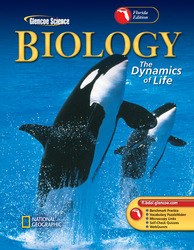1.
<a onClick="window.open('/olcweb/cgi/pluginpop.cgi?it=gif::::/sites/dl/free/0078694507/181858/ch11_0_a.gif','popWin', 'width=NaN,height=NaN,resizable,scrollbars');" href="#"><img valign="absmiddle" height="16" width="16" border="0" src="/olcweb/styles/shared/linkicons/image.gif"> (10.0K)</a> SC.F.2.4.2, SC.H.1.4.1 A) There is always more T than A in each of the DNA samples. B) The total amounts of A, T, G, and C in each DNA sample add to about 100%. C) C is represented in the smallest percentage for each of the DNA samples. D) C and G together compose at least 50% of each of the DNA samples. 2.
A) pyrimidines B) isotopes C) viruses D) purines 3.
SC.F.2.4.2 A) separation of strands&151;bonding of bases&151;replication&151;base pairing B) replication&151;bonding of bases&151;separation of strands&151;base pairing C) replication&151;bonding of bases&151;base pairing&151;separation of strands D) separation of strands &151;base pairing&151;bonding of bases&151;replication 4.
A) guanine B) thymine C) cytosine D) adenine 5.
SC.F.2.4.2 A) T-T-G-C-C-G-T-A B) C-G-T-A-A-T-G-G C) G-C-A-T-T-A-C-C D) T-A-C-G-G-C-A-A







